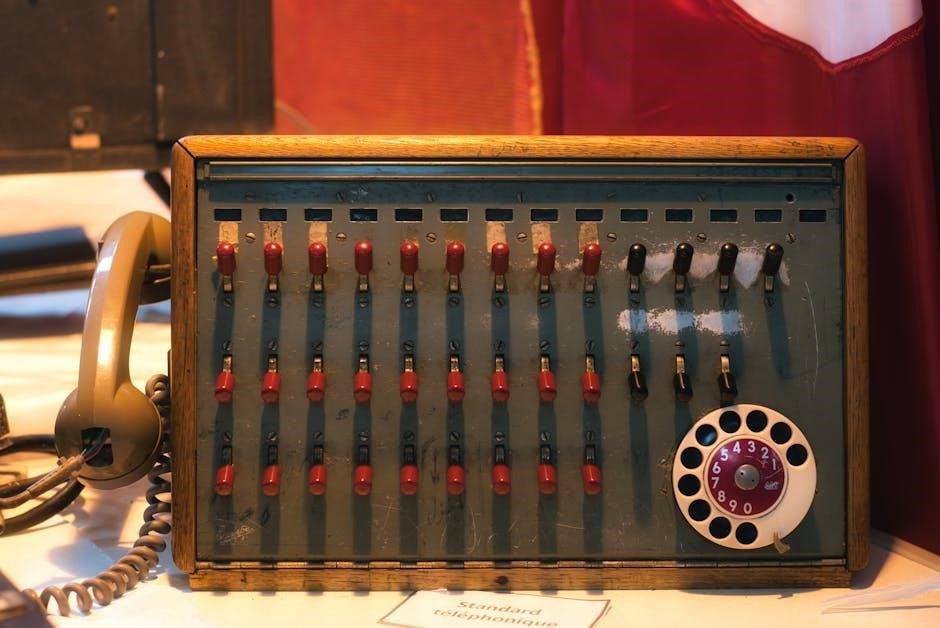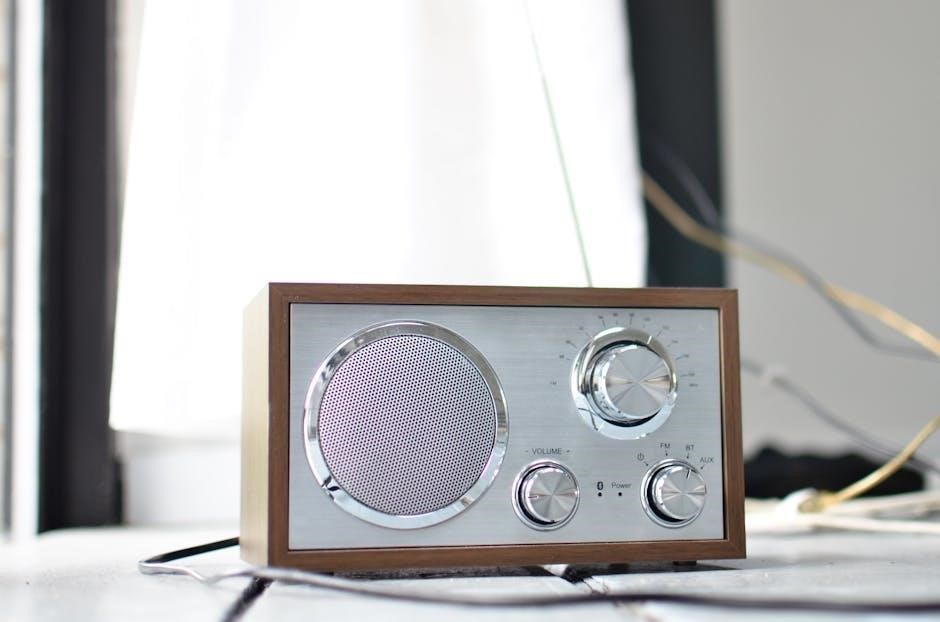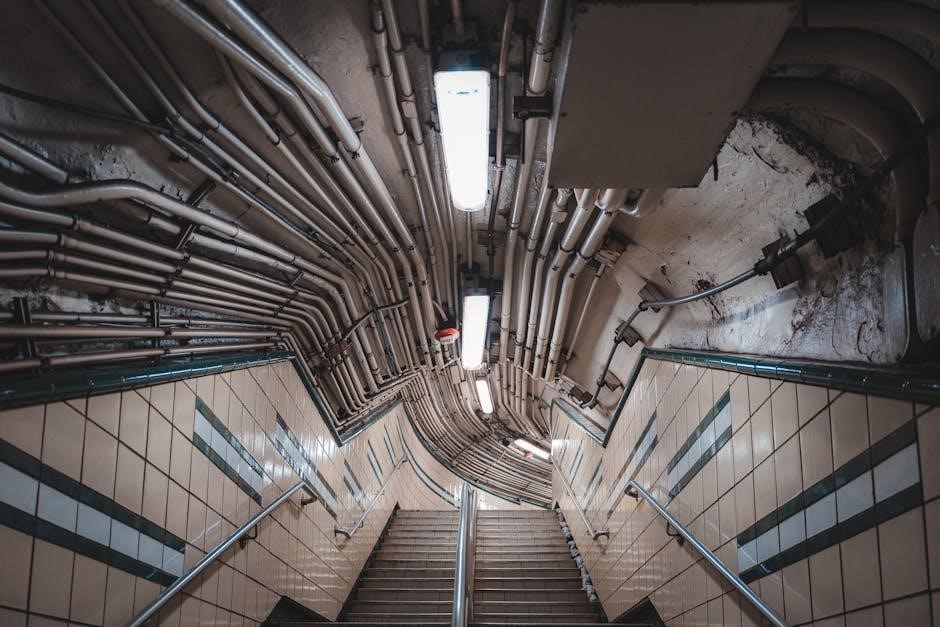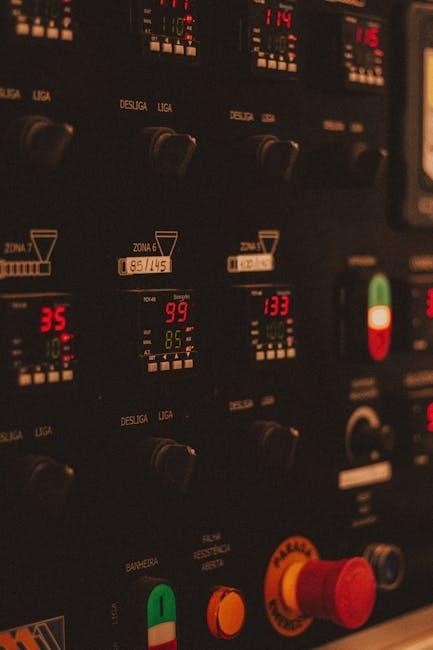A 3-way switch wiring diagram is a visual guide for installing and troubleshooting lighting circuits controlled by two or more switches. It ensures safe and efficient connections, simplifying complex configurations for professionals and DIYers alike. These diagrams are essential for understanding how to wire multiple lights, power feeds, and traveler wires properly. They provide clear instructions and visual representations, making it easier to manage electrical projects confidently. With detailed schematics and step-by-step instructions, 3-way switch wiring diagrams are indispensable for achieving correct and safe installations every time.
What is a 3-Way Switch?
A 3-way switch is an electrical device enabling control of a light fixture from two or more locations. It features three terminals: one common (black) and two traveler (brass) terminals. Unlike a standard switch, it doesn’t have an “on/off” position but directs the electrical current between terminals. This setup allows multiple switches to control the same light, making it ideal for staircases, hallways, or large rooms. The switch doesn’t contain a neutral wire connection, as it operates solely with hot (line) and traveler wires, ensuring versatile and efficient lighting control systems.
Common Applications of 3-Way Switches
3-way switches are commonly used in staircases, hallways, and large rooms where a single light fixture needs control from multiple locations. They are ideal for controlling ceiling lights, outdoor lighting, or basement illumination. These switches are also used in home theaters and smart home systems to create ambiance or convenience. Additionally, they are useful for controlling multiple light fixtures, making them a versatile solution for both residential and commercial settings. Their flexibility ensures efficient lighting control in various environments.
Why Use a Wiring Diagram?
A wiring diagram is crucial for safe and correct installation of 3-way switches. It provides a clear visual guide, ensuring all connections are made properly. By following the diagram, users can avoid mistakes, such as misconnecting wires, which could lead to electrical hazards or malfunctioning systems. Diagrams also help in understanding the role of each wire and terminal, making the process easier for both professionals and DIYers. They are essential for complex configurations, such as multiple lights or power feeds, ensuring the setup meets electrical standards and functions reliably.

Components of a 3-Way Switch System
A 3-way switch system includes two 3-way switches, line, load, traveler, neutral, and ground wires, along with terminals for connections. The system enables control of a light fixture from multiple locations using traveler wires to link switches.
Key Parts of a 3-Way Switch
A 3-way switch consists of three key terminals: the common terminal and two traveler terminals. The common terminal is typically black and connects to the live wire, while the traveler terminals (brass-colored) link the switches. The ground terminal (green or bare wire) ensures safety. These components work together to enable control of a light fixture from two locations, with the traveler wires carrying the electrical signal between switches. Proper wiring of these parts is essential for reliable operation and safety in any installation.
Understanding Wires: Line, Load, Neutral, and Travelers
In a 3-way switch system, the line wire (hot/live) carries power from the source, while the load wire connects to the light fixture. The neutral wire completes the circuit, ensuring proper current flow. Traveler wires, typically red and black, link the two switches, enabling the electrical signal to pass between them. These wires are crucial for controlling the light fixture from multiple locations. Proper identification and connection of these wires are essential for safe and functional installation, as outlined in wiring diagrams.
Color Coding for Safety and Efficiency
Color coding is essential for identifying wires in a 3-way switch system. The black wire is the live (hot) wire, while the white wire serves as the neutral. The green or bare wire is the ground, ensuring safety. Traveler wires, typically red and black, connect the switches. This standardized coloring helps prevent errors during installation and troubleshooting. By following these codes, you can ensure safe and efficient connections, minimizing risks and simplifying the wiring process for both professionals and DIY enthusiasts.
Step-by-Step Installation Guide
Start by connecting the live wire to the common terminal of the first switch. Use traveler wires to link the brass terminals between both switches. Ensure neutral and ground wires are securely connected for safety and proper functionality.
Connecting Live Wires to the Common Terminal
Connect the live (hot) wire to the common terminal of the first 3-way switch. This terminal is typically black or brass-colored. Ensure the connection is secure to maintain proper circuit functionality. If installing multiple lights or a light fixture between switches, follow the wiring diagram to correctly route the power supply. Always turn off the power at the circuit breaker before starting work to ensure safety. Double-checking connections and referring to the wiring diagram can help prevent errors and ensure the system operates as intended.
Linking Traveler Terminals Between Switches
Connect the traveler wires between the two 3-way switches by attaching one end of the red wire to a brass terminal on the first switch and the other end to a brass terminal on the second switch. Repeat this process with the black wire, ensuring it connects the remaining brass terminals. This setup allows the switches to communicate, enabling control of the light fixture from both locations. Always refer to a wiring diagram for accuracy and safety, and ensure the power is off before making any connections to prevent electrical hazards.
Neutral and Ground Wire Connections
Neutral and ground wires play a crucial role in 3-way switch systems, ensuring safety and proper circuit functionality. The neutral wire (typically white) should be connected directly to the light fixture or junction box, while the ground wire (bare or green) connects to the grounding terminal on both switches and the fixture. These connections are essential for completing the circuit and providing a safe path for fault currents. Always ensure these wires are securely attached and follow the wiring diagram to avoid electrical hazards. Proper grounding is critical for safety in any wiring project.

Advanced Wiring Configurations
Advanced wiring configurations for 3-way switches involve multiple lights, power feeds, and interconnected switches. These setups require precise wiring to ensure all components function seamlessly, providing reliable control over lighting from various locations. By following detailed diagrams and instructions, users can achieve complex configurations with confidence and safety. These configurations are ideal for larger spaces and customized lighting needs, offering flexibility and enhanced functionality in residential and commercial settings.
Multiple Lights Between Switches
Wiring multiple lights between 3-way switches allows for flexible control of lighting in larger areas. The configuration involves connecting the lights in parallel between the two switches, ensuring each light operates independently. Power can be fed at either the first switch, the last switch, or through the light fixture itself. Traveler wires connect the two switches, enabling the circuit to function smoothly. Neutral and ground wires must be properly connected to ensure safety and correct operation. This setup is ideal for hallways, staircases, or rooms requiring multi-location control, enhancing convenience and functionality.
Light Fixture Between Two 3-Way Switches
When a light fixture is installed between two 3-way switches, the wiring configuration ensures the light can be controlled from both locations. Power can be fed to the first switch, then wired to the light fixture, and finally connected to the second switch. Alternatively, power can be supplied directly to the light fixture, with switches controlling the circuit. Traveler wires connect the two switches, allowing them to communicate and toggle the light. Neutral and ground wires must be properly connected to ensure safe and reliable operation. This setup is ideal for hallways, staircases, or large rooms, providing convenient multi-location control over the lighting.
Power Feed at the Light Fixture
Power feed at the light fixture involves routing the electrical supply directly to the fixture, with switches controlling the circuit. This setup is useful for configurations where the fixture is between two 3-way switches. The traveler wires connect the switches, enabling them to toggle the light. Neutral and ground wires must be properly connected to ensure safety and functionality. This method is ideal for installations where the fixture serves as the central power distribution point, simplifying wiring complexity.

Troubleshooting Common Issues
Identify faulty wires, incorrect connections, or malfunctioning switches. Test switch functionality and verify power supply to resolve issues. Use diagrams for clarity and ensure safe, proper repairs.
Identifying Faulty Wires or Connections
Start by inspecting wires for signs of damage or wear. Use a multimeter to test for voltage and continuity. Verify traveler and common wire connections match the wiring diagram. Check for loose terminals or incorrect wire color assignments. Ensure all connections are secure and meet safety standards. If a light flickers or fails to turn on, suspect faulty wires or improper connections. Testing each wire’s functionality can isolate issues quickly. Always disconnect power before inspecting or repairing connections to avoid electrical hazards.
Testing Switch Functionality
After wiring, test each switch to ensure proper operation. Use a multimeter to verify voltage at terminals. Check if lights turn on/off from both switches. Ensure all positions function correctly. Test dimmer switches for smooth brightness control. Verify traveler wires are connected properly. If a switch malfunctions, check connections and wiring against the diagram. Ensure no short circuits or open circuits exist. Testing confirms correct installation and identifies issues early. Always disconnect power before performing detailed tests for safety. Proper functionality ensures reliable and safe operation of your lighting system.
Resolving Power Supply Problems
Power supply issues often arise from incorrect wiring or overloaded circuits. Check if power is fed correctly at the switch or light fixture. Verify traveler wires are connected properly between switches. Ensure the circuit isn’t overloaded with too many lights. Use a multimeter to test voltage at terminals. If power is absent, trace wires back to the source. Consult the wiring diagram to confirm connections. Always turn off power before testing. Correcting power supply issues ensures reliable operation and prevents electrical hazards. Proper troubleshooting restores functionality and safety to the system.

Downloadable 3-Way Switch Wiring Diagrams
To wire a 3-way switch, start by understanding the components involved. A 3-way switch allows control of a light fixture from multiple locations, typically using two switches connected by traveler wires.
Identify the Wires:
⎻ The “hot” (black) wire carries electricity.
౼ The “neutral” (white) wire completes the circuit.
౼ The “traveler” wires (often red and yellow) connect the two switches.
⎻ The ground wire (copper) ensures safety.
Common Terminal:
⎻ The “hot” wire connects to the common terminal on one of the switches.
Traveler Wires:
౼ Connect the traveler wires between the two switches. The specific terminals may vary, so consult a wiring diagram.
Power Source:
౼ Power can be fed to the light fixture first or to one of the switches. Ensure the configuration matches your setup.
Neutral Wire:
⎻ In a 3-way setup, the neutral wire may not be necessary at the switch, as the circuit is completed through the traveler wires.
Ground Wire:
⎻ Connect the ground wire to ensure electrical safety.
Testing:
⎻ Use a multimeter to test connections before turning the power on to avoid electrical hazards.
Consult a Diagram:
౼ Follow a reliable wiring diagram to ensure proper connections and avoid mistakes.
By following these steps and consulting a wiring diagram, you can safely and effectively wire a 3-way switch system. If unsure, consider consulting a professional to avoid electrical risks.
PDF Resources for Easy Reference
Downloadable 3-way switch wiring diagrams in PDF format provide clear, detailed visual guides for installing and troubleshooting lighting circuits. These resources are available from various online sources, offering step-by-step instructions and diagrams for multiple configurations, such as power at the switch or light, and wiring multiple lights. PDF diagrams are ideal for professionals and DIYers, ensuring safe and efficient installations. They often include color-coded wiring, terminal connections, and troubleshooting tips, making complex setups manageable. Access these resources to simplify your 3-way switch projects with precise visual guidance.
Visual Guides for Complex Configurations
Visual guides in 3-way switch wiring diagrams offer clear, detailed illustrations for complex setups, such as multiple lights, power feeds, and varied wiring configurations. These diagrams simplify intricate connections, ensuring precise wire routing and terminal assignments. They often include color-coded representations of live, neutral, and traveler wires, making it easier to identify and connect components. Whether you’re dealing with power at the switch, light, or multiple fixtures, these visual aids provide unmatched clarity, helping you navigate advanced wiring scenarios with confidence and accuracy.
Comments